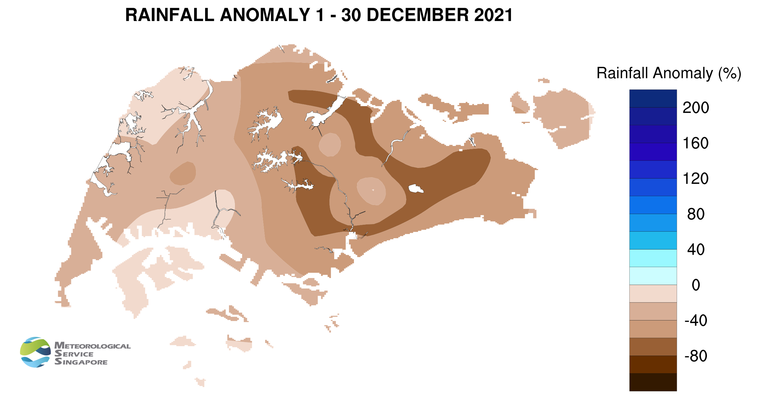Singapore, 31 December 2021 – The prevailing Northeast Monsoon conditions in the region are forecast to persist into January 2022, with low-level winds blowing from the northwest or northeast. At the start of the new year, a high-pressure system over the northern Asian continent is expected to strengthen and bring wetter and cooler conditions to the region.
2 The strengthening of the high-pressure system is expected to bring a surge of strong north-easterly winds (or monsoon surge ) over the South China Sea. The surge will last for a few days and will likely bring cooler conditions with occasional spells of moderate to heavy thundery showers over Singapore and the surrounding vicinity. Thereafter, localised thundery showers are forecast in the afternoon. The rainy weather is likely to ease in the second week of the fortnight. Localised short-duration thundery showers can still be expected in the afternoon on several days, and warm and occasionally windy conditions with passing showers on a few days. Overall, the rainfall for the first half of January 2022 is expected to be slightly above average over most parts of the island.
3 The rainy weather in early January 2022 is likely to result in lower daily temperatures of between 23 °C and 31 °C on a few days. For the rest of the fortnight, the daily temperatures are forecast to range between 24°C and 33°C. The daily maximum temperature may still reach a high of up to 34oC on a few days.
4 For updates of the daily weather forecast, please visit our MSS website (https://www.weather.gov.sg), NEA website (www.nea.gov.sg), or download the myENV app.
REVIEW (1 – 30 December 2021)
5 In December 2021, Northeast Monsoon conditions prevailed over Singapore and the surrounding region. During this period, the low-level winds blew from the northwest or northeast.
6 While December is climatologically a wetter month than November, December 2021 was drier compared to November 2021. The Northeast Monsoon brought relatively windy conditions with passing showers to Singapore and the surrounding region on most days in the first half of the month. Short-duration thundery showers fell over parts of the island in the afternoon on most days in the second half of December 2021. On a few days, large-scale convergence of winds over Singapore and the surrounding vicinity brought widespread moderate to heavy thundery showers. On the night of 18 December 2021, intense thundery showers fell over many parts of the island. The daily total rainfall recorded that day was 82.6 mm around the Pulau Ubin area. This was the highest total rainfall in a day for December 2021.
7 The daily temperature in December 2021 ranged between 22.1oC and 34.8oC. The highest daily maximum temperature of 34.8 °C was recorded on 1 December at Tengah. On 2 December 2021, the passage of a Sumatra squall brought rainy weather and cloudy skies to Singapore, and the minimum temperature at Jurong dropped to a low of 22.1°C.
8 At the Changi climate station, the daily maximum temperature of 33.9°C recorded on 1 December 2021 was the highest daily maximum temperature ever recorded at our climate station in December. The mean monthly temperature of 27.7°C (as of 30 Dec 2021) was 0.9°C warmer than the long-term December mean temperature.
9 Singapore received below-average rainfall in December 2021. The highest anomaly of 71% below average was recorded at Seletar. The lowest anomaly of 7% below average was at Jurong Pier.
CLIMATE STATION STATISTICS
Long-term Statistics for January
(Climatological reference period: 1991 – 2020)
| Average daily maximum temperature: | 30.6 °C |
| Average daily minimum temperature: | 24.3 °C |
| Average monthly temperature: | 26.8 °C |
| Average rainfall: | 221.6 mm |
| Average number of rain days: | 13 |
Historical Extremes for January
(Rainfall since 1869 and temperature since 1929)
| Highest monthly mean daily maximum temperature: | 31.8 °C (2016, 2018) |
| Lowest monthly mean daily minimum temperature: | 21.6 °C (1933) |
| Highest monthly rainfall ever recorded: | 818.6 mm (2006) |
| Lowest monthly rainfall ever recorded: | 15.4 mm (1932) |

